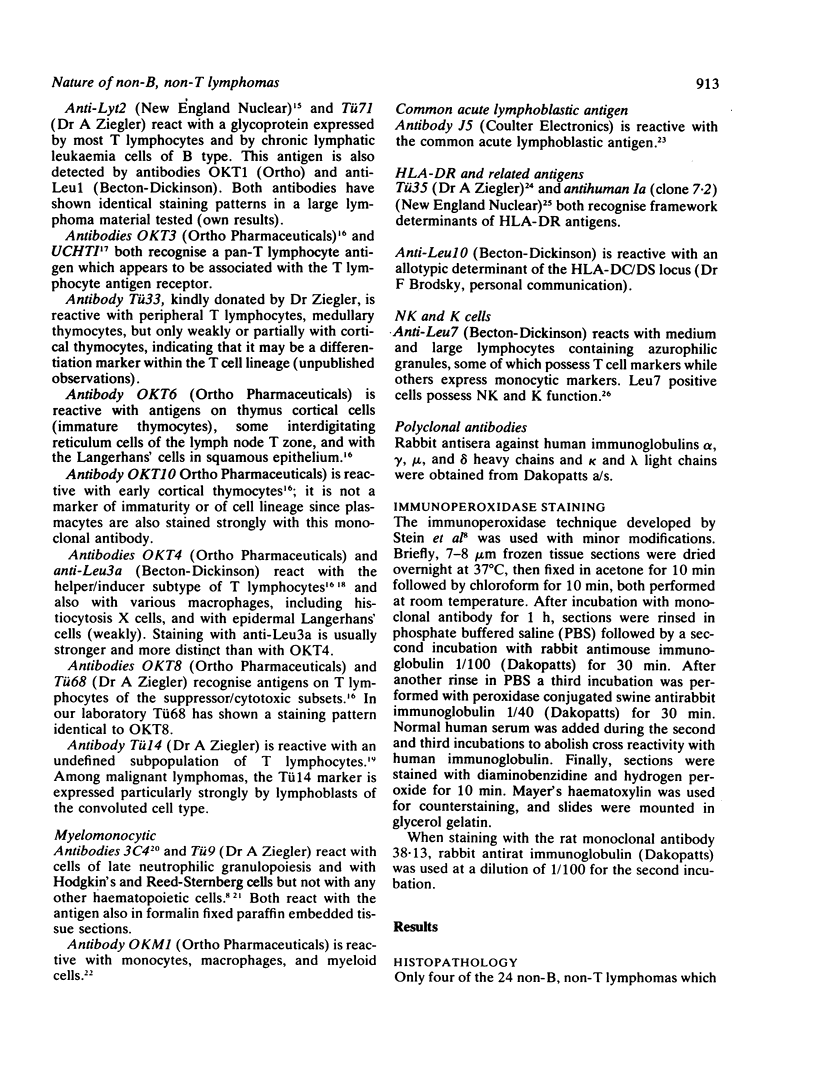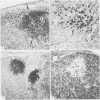Abstract
In a previous study employing conventional immunological marker analysis we found that 17% of high grade malignant lymphomas were devoid of cytoplasmic and membrane immunoglobulin and also sheep erythrocyte receptors. Cryostat sections from 24 of these cases (four of low grade and 20 of high grade malignancy) were stained with a panel of 30 monoclonal antibodies and six polyclonal antisera using a sensitive immunoperoxidase method. All tumours expressed the leucocyte common antigen (detected by monoclonal antibody 2D1) and all lacked epithelial cytokeratin (monoclonal antibody LE61), confirming their haematopoietic origin. All but one of the lymphomas expressed antigens characteristic of either B cells (17 cases) or T cells (six cases), while one case (morphologically a centroblastic lymphoma) had an unusual dual phenotype in which strong staining for T6 (marker of immature T cells) was associated with expression of the pan B lymphocyte antigens detectable with To15, anti-B1, anti-Leu12. This case was therefore classified as a B cell lymphoma showing aberrant expression of the T6 antigen. The pan B cell antibodies (To15, anti-B1, anti-Leu12) all appeared highly specific and sensitive, but the simultaneous use of all three monoclonal antibodies was necessary to detect the B cell nature in each of the 18 lymphomas. A wider panel of monoclonal antibodies was required to detect T lymphomas since these often disclosed atypical and restricted phenotypes. To15 and UCHT1 were the most reliable antibodies for the detection of B and T cell neoplasms, respectively. We conclude that most, if not all, "non-B, non-T" lymphomas are of either B or T lymphocyte origin and that monoclonal antibodies provide indispensable tools in their classification and diagnosis.
Full text
PDF







Images in this article
Selected References
These references are in PubMed. This may not be the complete list of references from this article.
- Abo T., Balch C. M. A differentiation antigen of human NK and K cells identified by a monoclonal antibody (HNK-1). J Immunol. 1981 Sep;127(3):1024–1029. [PubMed] [Google Scholar]
- Beverley P. C., Callard R. E. Distinctive functional characteristics of human "T" lymphocytes defined by E rosetting or a monoclonal anti-T cell antibody. Eur J Immunol. 1981 Apr;11(4):329–334. doi: 10.1002/eji.1830110412. [DOI] [PubMed] [Google Scholar]
- Breard J., Reinherz E. L., Kung P. C., Goldstein G., Schlossman S. F. A monoclonal antibody reactive with human peripheral blood monocytes. J Immunol. 1980 Apr;124(4):1943–1948. [PubMed] [Google Scholar]
- Evans R. L., Wall D. W., Platsoucas C. D., Siegal F. P., Fikrig S. M., Testa C. M., Good R. A. Thymus-dependent membrane antigens in man: inhibition of cell-mediated lympholysis by monoclonal antibodies to TH2 antigen. Proc Natl Acad Sci U S A. 1981 Jan;78(1):544–548. doi: 10.1073/pnas.78.1.544. [DOI] [PMC free article] [PubMed] [Google Scholar]
- Gatter K. C., Abdulaziz Z., Beverley P., Corvalan J. R., Ford C., Lane E. B., Mota M., Nash J. R., Pulford K., Stein H. Use of monoclonal antibodies for the histopathological diagnosis of human malignancy. J Clin Pathol. 1982 Nov;35(11):1253–1267. doi: 10.1136/jcp.35.11.1253. [DOI] [PMC free article] [PubMed] [Google Scholar]
- Greaves M., Delia D., Sutherland R., Rao J., Verbi W., Kemshead J., Hariri G., Goldstein G., Kung P. Expression of the OKT monoclonal antibody defined antigenic determinants in malignancy. Int J Immunopharmacol. 1981;3(3):283–299. doi: 10.1016/0192-0561(81)90022-9. [DOI] [PubMed] [Google Scholar]
- Lane E. B. Monoclonal antibodies provide specific intramolecular markers for the study of epithelial tonofilament organization. J Cell Biol. 1982 Mar;92(3):665–673. doi: 10.1083/jcb.92.3.665. [DOI] [PMC free article] [PubMed] [Google Scholar]
- Martin P. J., Hansen J. A., Nowinski R. C., Brown M. A. A new human T-cell differentiation antigen: unexpected expression on chronic lymphocytic leukemia cells. Immunogenetics. 1980;11(5):429–439. doi: 10.1007/BF01567812. [DOI] [PubMed] [Google Scholar]
- Pallesen G., Madsen M., Schifter S. Immune marker expression in 53 lymphomas of high-grade malignancy. Histopathology. 1983 Nov;7(6):841–857. doi: 10.1111/j.1365-2559.1983.tb02300.x. [DOI] [PubMed] [Google Scholar]
- Pizzolo G., Sloane J., Beverley P., Thomas J. A., Bradstock K. F., Mattingly S., Janossy G. Differential diagnosis of malignant lymphoma and nonlymphoid tumors using monoclonal anti-leucocyte antibody. Cancer. 1980 Dec 15;46(12):2640–2647. doi: 10.1002/1097-0142(19801215)46:12<2640::aid-cncr2820461218>3.0.co;2-s. [DOI] [PubMed] [Google Scholar]
- Reinherz E. L., Kung P. C., Goldstein G., Levey R. H., Schlossman S. F. Discrete stages of human intrathymic differentiation: analysis of normal thymocytes and leukemic lymphoblasts of T-cell lineage. Proc Natl Acad Sci U S A. 1980 Mar;77(3):1588–1592. doi: 10.1073/pnas.77.3.1588. [DOI] [PMC free article] [PubMed] [Google Scholar]
- Ritz J., Nadler L. M., Bhan A. K., Notis-McConarty J., Pesando J. M., Schlossman S. F. Expression of common acute lymphoblastic leukemia antigen (CALLA) by lymphomas of B-cell and T-cell lineage. Blood. 1981 Sep;58(3):648–652. [PubMed] [Google Scholar]
- Rudders R. A., Ahl E. T., Jr, DeLellis R. A. Surface marker and histopathologic correlation with long-term survival in advanced large-cell non-Hodgkin's lymphoma. Cancer. 1981 Mar 15;47(6):1329–1335. doi: 10.1002/1097-0142(19810315)47:6<1329::aid-cncr2820470616>3.0.co;2-x. [DOI] [PubMed] [Google Scholar]
- Schienle H. W., Stein N., Müller-Ruchholtz W. Neutrophil granulocytic cell antigen defined by a monoclonal antibody--its distribution within normal haemic and non-haemic tissue. J Clin Pathol. 1982 Sep;35(9):959–966. doi: 10.1136/jcp.35.9.959. [DOI] [PMC free article] [PubMed] [Google Scholar]
- Stashenko P., Nadler L. M., Hardy R., Schlossman S. F. Characterization of a human B lymphocyte-specific antigen. J Immunol. 1980 Oct;125(4):1678–1685. [PubMed] [Google Scholar]
- Stein H., Gerdes J., Schwab U., Lemke H., Mason D. Y., Ziegler A., Schienle W., Diehl V. Identification of Hodgkin and Sternberg-reed cells as a unique cell type derived from a newly-detected small-cell population. Int J Cancer. 1982 Oct 15;30(4):445–459. doi: 10.1002/ijc.2910300411. [DOI] [PubMed] [Google Scholar]
- Verbi W., Greaves M. F., Schneider C., Koubek K., Janossy G., Stein H., Kung P., Goldstein G. Monoclonal antibodies OKT 11 and OKT 11A have pan-T reactivity and block sheep erythrocyte "receptors". Eur J Immunol. 1982 Jan;12(1):81–86. doi: 10.1002/eji.1830120115. [DOI] [PubMed] [Google Scholar]
- Warnke R., Miller R., Grogan T., Pederson M., Dilley J., Levy R. Immunologic phenotype in 30 patients with diffuse large-cell lymphoma. N Engl J Med. 1980 Aug 7;303(6):293–300. doi: 10.1056/NEJM198008073030601. [DOI] [PubMed] [Google Scholar]
- Wiels J., Fellous M., Tursz T. Monoclonal antibody against a Burkitt lymphoma-associated antigen. Proc Natl Acad Sci U S A. 1981 Oct;78(10):6485–6488. doi: 10.1073/pnas.78.10.6485. [DOI] [PMC free article] [PubMed] [Google Scholar]
- Ziegler A., Uchańska-Ziegler B., Zeuthen J., Wernet P. HLA antigen expression at the single cell level on a K562 X B cell hybrid: an analysis with monoclonal antibodies using bacterial binding assays. Somatic Cell Genet. 1982 Nov;8(6):775–789. doi: 10.1007/BF01543018. [DOI] [PubMed] [Google Scholar]



